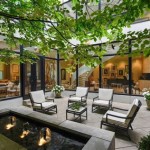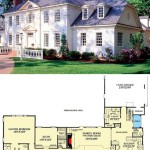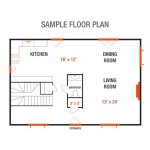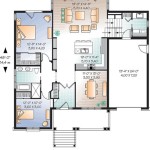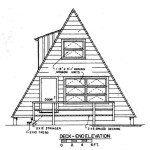Adobe house plans are architectural blueprints that provide detailed instructions for the construction of houses using adobe, a natural building material made from soil, clay, and water. Adobe houses are popular in arid and semi-arid climates, where their thermal mass helps to regulate indoor temperatures, reducing the need for heating and cooling systems. An example of an adobe house plan is the “Taos Pueblo Revival” style, which incorporates traditional Native American architectural elements into modern designs.
Adobe house plans typically include floor plans, elevations, cross-sections, and construction details. They provide architects, builders, and homeowners with a comprehensive overview of the design, materials, and construction techniques to be used in the project. These plans help ensure that the house is structurally sound, energy-efficient, and aesthetically pleasing. Adobe house plans often incorporate sustainable design principles, such as passive solar heating and natural ventilation.
In this article, we will delve into the various aspects of adobe house plans, exploring their benefits, design considerations, and construction techniques. We will also provide tips for selecting the right adobe house plan and working with an architect or builder to create a custom design.
Here are 8 important points about adobe house plans:
- Sustainable
- Energy-efficient
- Thermally massive
- Fire-resistant
- Low-maintenance
- Versatile
- Customizable
- Affordable
These plans offer a range of benefits and design options, making them a popular choice for homeowners in arid and semi-arid climates.
Sustainable
Adobe house plans are sustainable because they use natural and renewable materials, such as soil, clay, and water. Adobe is a low-carbon building material, meaning that it has a low environmental impact during its production and use. Additionally, adobe houses are energy-efficient, which reduces the need for fossil fuels and greenhouse gas emissions.
- Renewable materials
Adobe is made from soil, clay, and water, which are all renewable resources. This means that adobe houses can be built without depleting the earth’s natural resources.
- Low-carbon footprint
The production of adobe does not require the use of fossil fuels or other energy-intensive processes. This means that adobe houses have a low carbon footprint compared to houses built with other materials, such as concrete or steel.
- Energy-efficient
Adobe houses are energy-efficient because they have a high thermal mass. This means that they absorb and store heat from the sun during the day, and then release it slowly at night. This helps to regulate indoor temperatures, reducing the need for heating and cooling systems.
- Reduced waste
Adobe houses can be built with minimal waste. The materials used in adobe construction are often locally sourced, which reduces transportation costs and emissions. Additionally, adobe houses can be recycled at the end of their lifespan.
Overall, adobe house plans are a sustainable choice for homeowners who are looking to build an environmentally friendly home.
Energy-efficient
Adobe house plans are energy-efficient because they incorporate design features and building materials that reduce the need for heating and cooling systems. Adobe’s high thermal mass helps to regulate indoor temperatures, keeping homes cool in the summer and warm in the winter. Additionally, adobe houses can be designed to take advantage of passive solar heating and natural ventilation.
- Thermal mass
Thermal mass is the ability of a material to absorb and store heat. Adobe has a high thermal mass, which means that it can absorb and store heat from the sun during the day, and then release it slowly at night. This helps to regulate indoor temperatures, reducing the need for heating and cooling systems.
- Passive solar heating
Passive solar heating is a design strategy that uses the sun’s energy to heat a building. Adobe houses can be designed to take advantage of passive solar heating by orienting the house to face the sun, and by using large windows to allow sunlight to enter the home. The sunlight is absorbed by the adobe walls and floor, which then release the heat slowly throughout the day.
- Natural ventilation
Natural ventilation is a design strategy that uses the natural movement of air to cool a building. Adobe houses can be designed to take advantage of natural ventilation by using cross-ventilation, which is the movement of air through a building from one side to the other. Cross-ventilation can be achieved by placing windows and doors on opposite sides of the house.
- Energy-efficient appliances and fixtures
In addition to design features, adobe house plans can also incorporate energy-efficient appliances and fixtures. These appliances and fixtures can help to reduce energy consumption and utility bills. Some examples of energy-efficient appliances and fixtures include LED lighting, Energy Star appliances, and low-flow plumbing fixtures.
By incorporating these design features and building materials, adobe house plans can help to create energy-efficient homes that are comfortable to live in and affordable to operate.
Thermally massive
Thermal mass is the ability of a material to absorb and store heat. Adobe has a high thermal mass, which means that it can absorb and store heat from the sun during the day, and then release it slowly at night. This helps to regulate indoor temperatures, reducing the need for heating and cooling systems.
The thermal mass of adobe is due to its high density and specific heat capacity. Density is the mass of a material per unit volume, and specific heat capacity is the amount of heat required to raise the temperature of a unit mass of a material by one degree Celsius. Adobe has a high density and a high specific heat capacity, which means that it can absorb and store a lot of heat.
The thermal mass of adobe is beneficial in both hot and cold climates. In hot climates, the thermal mass of adobe helps to keep indoor temperatures cool during the day. The adobe walls absorb heat from the sun during the day, and then release it slowly at night, when the outside temperatures are cooler. This helps to keep the indoor temperature more stable and comfortable.
In cold climates, the thermal mass of adobe helps to keep indoor temperatures warm during the day. The adobe walls absorb heat from the sun during the day, and then release it slowly at night, when the outside temperatures are colder. This helps to keep the indoor temperature more stable and comfortable.
The thermal mass of adobe is a major advantage of adobe house plans. It helps to regulate indoor temperatures, reducing the need for heating and cooling systems. This can lead to significant energy savings and cost savings over the life of the home.
Fire-resistant
Adobe house plans are fire-resistant because adobe is a non-combustible material. This means that it will not burn or support combustion. Adobe is made from soil, clay, and water, which are all inorganic materials that do not contain any flammable compounds.
- Non-combustible
Adobe is a non-combustible material, meaning that it will not burn or support combustion. This is because adobe does not contain any flammable compounds. When exposed to fire, adobe will simply char and turn to ash.
- High thermal mass
Adobe has a high thermal mass, which means that it can absorb and store a lot of heat. This helps to protect the interior of an adobe house from fire. When exposed to fire, the adobe walls will absorb the heat and slow the spread of the fire.
- Earthen construction
Adobe houses are typically built using earthen construction techniques. This means that the walls are made from thick layers of adobe bricks or rammed earth. Earthen construction is naturally fire-resistant because the thick walls provide a barrier to the spread of fire.
- Fire codes
Adobe house plans must comply with all applicable fire codes. This includes codes related to fire resistance, smoke detectors, and fire extinguishers. By following the fire codes, homeowners can help to ensure that their adobe house is safe from fire.
The fire-resistant properties of adobe make it an ideal building material for homes in fire-prone areas. Adobe houses can withstand high temperatures and slow the spread of fire, which can help to protect the lives of the occupants and the property itself.
Low-maintenance
Adobe house plans are low-maintenance because adobe is a durable material that requires minimal upkeep. Adobe walls are resistant to cracking, fading, and peeling, and they can withstand harsh weather conditions, such as rain, snow, and wind. Additionally, adobe is a fire-resistant material, which means that it is less likely to be damaged in a fire.
The low-maintenance nature of adobe house plans is due to the unique properties of adobe. Adobe is a composite material made from soil, clay, and water. When these materials are mixed together and compacted, they form a strong and durable material. Adobe is also a breathable material, which means that it can absorb and release moisture, helping to regulate indoor humidity levels.
The low-maintenance benefits of adobe house plans are significant. Adobe homes require less painting, repairs, and maintenance than homes built with other materials, such as wood or concrete. This can lead to significant cost savings over the life of the home.
In addition to being low-maintenance, adobe house plans are also energy-efficient, fire-resistant, and sustainable. These factors, combined with the low-maintenance benefits, make adobe house plans a popular choice for homeowners who are looking for a durable, low-maintenance, and environmentally friendly home.
Overall, adobe house plans are a low-maintenance option for homeowners who are looking for a durable and sustainable home. Adobe homes require minimal upkeep and can withstand harsh weather conditions, making them a good choice for homeowners in any climate.
Versatile
Adobe house plans are versatile because adobe is a material that can be used to create a wide variety of architectural styles. Adobe homes can be designed to be traditional or modern, simple or elaborate, small or large. Additionally, adobe can be used to create a variety of interior and exterior features, such as fireplaces, ovens, and courtyards.
- Traditional and modern styles
Adobe house plans can be designed to be traditional or modern, depending on the homeowner’s preferences. Traditional adobe homes often feature thick walls, small windows, and a courtyard. Modern adobe homes often feature clean lines, large windows, and open floor plans.
- Simple and elaborate designs
Adobe house plans can be simple or elaborate, depending on the homeowner’s budget and needs. Simple adobe homes often have a basic rectangular shape and few interior features. Elaborate adobe homes may have multiple stories, complex rooflines, and a variety of interior and exterior features.
- Small and large homes
Adobe house plans can be designed to create small or large homes, depending on the homeowner’s needs. Small adobe homes are often suitable for couples or small families. Large adobe homes are often suitable for large families or multi-generational living.
- Customizable features
Adobe house plans can be customized to include a variety of interior and exterior features, such as fireplaces, ovens, and courtyards. Fireplaces and ovens can be built into the adobe walls, and courtyards can be created by enclosing a portion of the yard with adobe walls.
The versatility of adobe house plans makes them a popular choice for homeowners who are looking for a unique and customizable home. Adobe homes can be designed to suit any taste or budget, and they can be built to withstand the test of time.
Customizable
Adobe house plans are highly customizable, which means that they can be tailored to meet the specific needs and preferences of the homeowner. This is due to the versatility of adobe as a building material. Adobe is easy to mold and shape, and it can be used to create a wide variety of architectural features. Additionally, adobe homes can be easily expanded or remodeled, making them a good choice for homeowners who plan to stay in their home for many years.
- Floor plans
Adobe house plans can be customized to create a variety of floor plans. This includes the number of bedrooms and bathrooms, the size and shape of the rooms, and the overall layout of the home. Homeowners can work with an architect to design a floor plan that meets their specific needs and preferences.
- Exterior features
Adobe house plans can also be customized to include a variety of exterior features. This includes the type of roof, the style of the windows and doors, and the overall exterior finish. Homeowners can choose from a variety of exterior finishes, such as stucco, plaster, or paint.
- Interior features
Adobe house plans can also be customized to include a variety of interior features. This includes the type of flooring, the style of the cabinetry, and the overall interior design. Homeowners can choose from a variety of interior finishes, such as tile, hardwood, or carpet.
- Sustainable features
Adobe house plans can also be customized to include a variety of sustainable features. This includes the use of solar panels, rainwater harvesting systems, and energy-efficient appliances. Homeowners can work with an architect to design a sustainable home that meets their specific needs and preferences.
The customizable nature of adobe house plans makes them a popular choice for homeowners who are looking for a unique and personalized home. Adobe homes can be designed to suit any taste or budget, and they can be built to withstand the test of time.
Affordable
Adobe house plans are affordable because adobe is a low-cost building material. Adobe is made from soil, clay, and water, which are all readily available materials in many parts of the world. Additionally, adobe homes can be built using simple construction techniques, which reduces the cost of labor.
- Low cost of materials
Adobe is a low-cost building material because it is made from natural materials that are readily available in many parts of the world. Soil, clay, and water are all free or inexpensive materials, which can significantly reduce the cost of building an adobe home.
- Simple construction techniques
Adobe homes can be built using simple construction techniques, which reduces the cost of labor. Adobe bricks are easy to make and can be laid by hand. Additionally, adobe homes do not require specialized tools or equipment to build.
- Energy efficiency
Adobe homes are energy-efficient, which can save homeowners money on their energy bills. The thick adobe walls help to insulate the home, reducing the need for heating and cooling. Additionally, adobe homes can be designed to take advantage of passive solar heating, which can further reduce energy costs.
- Low maintenance
Adobe homes are low-maintenance, which can save homeowners money over the life of the home. Adobe walls are durable and resistant to cracking, fading, and peeling. Additionally, adobe homes do not require painting or other regular maintenance tasks.
The affordability of adobe house plans makes them a good choice for homeowners who are looking for a cost-effective and sustainable home. Adobe homes are built using natural materials, simple construction techniques, and energy-efficient design features. This can lead to significant savings on the cost of building and maintaining an adobe home.










Related Posts



